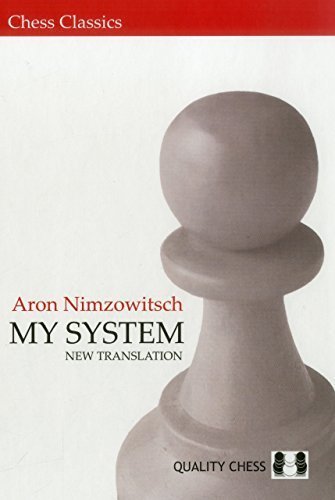I have a chess friend – a strong player who loves winning against other players, especially weaker ones.
He does this funny thing though – After winning games (say 2 or 3) against a weaker opponent, he jokes about giving the opponent the book, My System by Aron Nimzowitsch so they can study and get better.
Every time he does it, it’s just so amusing but the truth is he’s not wrong in recommending that book.
I’ve been to chess clubs and watched a lot of games, and one thing I’ve clearly observed is that a lot of chess players don’t pay attention to basic chess principles and ideas.
When I’m talking chess principles, I mean these:
- Lead in development
- Gaining Tempo
- Rook on 7th ranks
- Blockading and advancing passed pawns
- Pinning and unpinning pieces
- Prophylaxis (predicting opponent moves) and much more.
Most players especially beginners simply pay one-sided attention to tactics alone without ever considering elements of positional play.
But the thing is you can only go far as an improving chess player when you understand that chess is both strategic (positional) and tactical.
This irregularity is what the book ‘My System’ corrects in this amazing classic written by Aron Nimzowitsch in 1925.
Aron was one of the greatest chess players of the 1920s and 1930s just behind then famous world champions Alekhine and Capablanca.
This book has been described as being ahead of its time because it’s not just an ordinary chess book but a comprehensive manual that even grandmasters and world champions have studied and implemented in their games.
What Does The Book Teach?

My System was originally published in German as a series of five brochures from 1925 to 1927.
The book introduced many new concepts to followers of the modern school of thought and is considered one of the most important books in the history of chess.
Since then, it has undergone translations to help everyone around the world get easy access to this world-class material.
According to this translation by Quality Chess, the book is divided into two parts: “The Elements” and “Positional Play”.
In Part 1 (The Elements), Nimzowitsch highlights the ‘basics of his system’ and basic elements of chess strategy:
- The centre
- Open files
- Play on 7th and 8th ranks
- The passed pawn
- The pin
- Discovered check
- The pawn chain
- Exchanging
He then proceeds to break down each element in as much detail as possible.
Chess positions are captured alongside algebraic notations to help you read this book even if you have no chess board by your side.
The book is written in an easy-to-read manner with the author explaining games and positions in first person perspective.
In Part 2 (Positional Play), Nimzowitsch discusses topics based on the elements earlier discussed such as:

- Prophylaxis
- Doubled pawns and restraint
- The isolated queen’s pawn and its descendants
- Overprotection and weak pawns
- Manoeuvring
Finally, there’s a postscript that talks about:
- The history of the revolution of chess from 1911 – 1914
- The chess career of Aron Nimzowitsch (basically performance in tournaments)
There are also illustrative games that contain annotated versions of Nimzowitsch’s career games.
The book’s accuracy is unmatched for something that was written in the 1900s when there were no chess engines like Stockfish and Komodo.
However, like any other chess book, it’s still prone to mistakes.
This new translation by Quality Chess highlights some positions at the end of the book that complete Nimzowitsch’s analysis or correct some major oversights that he may have missed.

Who is My System For?
I’ll say ‘everyone’…as long as you’re a breathing chess player.
The book might be difficult to read but it’s hard to ignore a book that teaches you all the basic elements of the game – I suspect that chess engines were trained on these principles to help their evaluations.
If you’re a master of the game and have never read My System, I’m also led to believe that the other chess materials you studied were products of this classic by Nimzowitsch, that’s how important it is.
Final Thoughts
As a beginner, it’s not enough to get into chess by studying just tactics exclusively.
I had another chess friend who didn’t even study chess at all…just played from inspiration and experience.
It wasn’t long before I started beating him consistently and surpassed him in rating simply because I took the effort to learn the basic elements of chess strategy and applied them to my games.
I’d highly recommend this book to players within the rating range of 0 – 2100 FIDE. That’s complete beginners to candidate masters.
Others may disagree with me with the opinion that the book is only good for intermediate players and above (1500 FIDE+).
Honestly, this all depends on individual players. I strongly hold that the book will be really useful to a newbie, just in the same way it helped my playing strength.
And finally, this book is not just one you study and dump…it’s one you may need to go over again and again till it becomes part of you.
Let me know if you found this review helpful.
